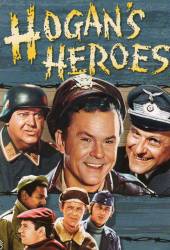Continuity mistake: LeBeau and Newkirk are on a building roof and the Nazi flag is blowing in the wind with great force. In the next shot a guard tower is shown with a Nazi flag that's hanging straight down and not blowing at all. (00:01:00)
Continuity mistake: As Schultz is telling Hogan that he's a family man, the shot ends with Hogan starting to turn his head to the left. The next shot shows Hogan looking straight at Schultz, then turning his head. (00:15:25)
Other mistake: After talking to the officers in the Höfbräu, the scene shifts to a closed business with Hogan talking to the waitress. As it shifts, the cameraman accidentally shakes the camera.
Factual error: Hogan mentions a store that offers "thirty percent off on T-shirts." T-shirts were mostly unknown in Germany during the 3rd Reich, and didn't see widespread use before the 1960s. Before that, the traditional Unterhemd, known in America as tank top or wife beater, was worn almost exclusively.






Answer: It's a comedy, not a documentary.
stiiggy
Perhaps it was counterfeit. There are numerous episodes where they deal in counterfeit monies.